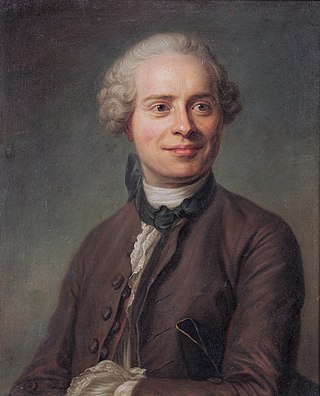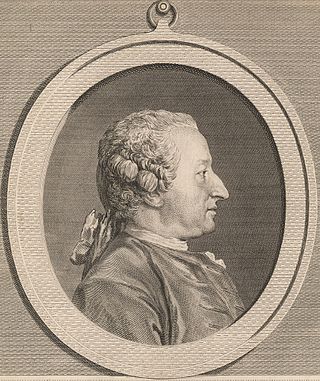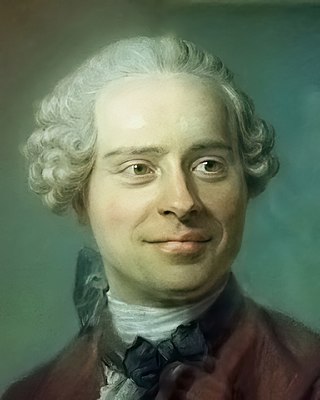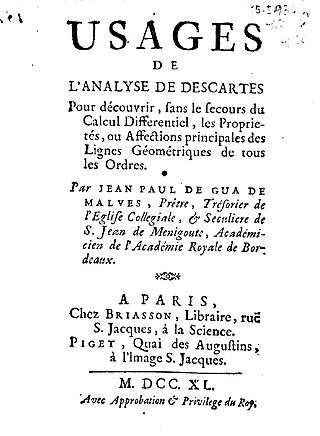d'Alembert may refer to:

Denis Diderot was a French philosopher, art critic, and writer, best known for serving as co-founder, chief editor, and contributor to the Encyclopédie along with Jean le Rond d'Alembert. He was a prominent figure during the Age of Enlightenment.

Edward Waring was a British mathematician. He entered Magdalene College, Cambridge as a sizar and became Senior wrangler in 1757. He was elected a Fellow of Magdalene and in 1760 Lucasian Professor of Mathematics, holding the chair until his death. He made the assertion known as Waring's problem without proof in his writings Meditationes Algebraicae. Waring was elected a Fellow of the Royal Society in 1763 and awarded the Copley Medal in 1784.

Jean-Baptiste le Rond d'Alembert was a French mathematician, mechanician, physicist, philosopher, and music theorist. Until 1759 he was, together with Denis Diderot, a co-editor of the Encyclopédie. d'Alembert's formula for obtaining solutions to the wave equation is named after him. The wave equation is sometimes referred to as d'Alembert's equation, and the fundamental theorem of algebra is named after d'Alembert in French.
The following is a timeline of classical mechanics:

Encyclopédie, ou dictionnaire raisonné des sciences, des arts et des métiers, better known as Encyclopédie, was a general encyclopedia published in France between 1751 and 1772, with later supplements, revised editions, and translations. It had many writers, known as the Encyclopédistes. It was edited by Denis Diderot and, until 1759, co-edited by Jean le Rond d'Alembert.

Alexis Claude Clairaut was a French mathematician, astronomer, and geophysicist. He was a prominent Newtonian whose work helped to establish the validity of the principles and results that Sir Isaac Newton had outlined in the Principia of 1687. Clairaut was one of the key figures in the expedition to Lapland that helped to confirm Newton's theory for the figure of the Earth. In that context, Clairaut worked out a mathematical result now known as "Clairaut's theorem". He also tackled the gravitational three-body problem, being the first to obtain a satisfactory result for the apsidal precession of the Moon's orbit. In mathematics he is also credited with Clairaut's equation and Clairaut's relation.
In special relativity, electromagnetism and wave theory, the d'Alembert operator, also called the d'Alembertian, wave operator, box operator or sometimes quabla operator is the Laplace operator of Minkowski space. The operator is named after French mathematician and physicist Jean le Rond d'Alembert.
The year 1746 in science and technology involved some significant events.

In fluid dynamics, d'Alembert's paradox is a contradiction reached in 1752 by French mathematician Jean le Rond d'Alembert. d'Alembert proved that – for incompressible and inviscid potential flow – the drag force is zero on a body moving with constant velocity relative to the fluid. Zero drag is in direct contradiction to the observation of substantial drag on bodies moving relative to fluids, such as air and water; especially at high velocities corresponding with high Reynolds numbers. It is a particular example of the reversibility paradox.

d'Alembert's principle, also known as the Lagrange–d'Alembert principle, is a statement of the fundamental classical laws of motion. It is named after its discoverer, the French physicist and mathematician Jean le Rond d'Alembert, and Italian-French mathematician Joseph Louis Lagrange. d'Alembert's principle generalizes the principle of virtual work from static to dynamical systems by introducing forces of inertia which, when added to the applied forces in a system, result in dynamic equilibrium.
The Encyclopédistes were members of the Société des gens de lettres, a French writers' society, who contributed to the development of the Encyclopédie from June 1751 to December 1765 under the editors Denis Diderot and Jean le Rond d'Alembert, and only Diderot from 1765 to 1772.

Jean Paul de Gua de Malves was a French mathematician who published in 1740 a work on analytical geometry in which he applied it, without the aid of differential calculus, to find the tangents, asymptotes, and various singular points of an algebraic curve.
In mathematics, d'Alembert's equation is a first order nonlinear ordinary differential equation, named after the French mathematician Jean le Rond d'Alembert. The equation reads as
De Bruijn is a Dutch surname meaning "the brown". Notable people with the surname include:
Alembert and its variants may refer to:
d'Alembert's Dream is an ensemble of three philosophical dialogues authored by Denis Diderot in 1769, which first anonymously appeared in the Correspondance littéraire, philosophique et critique between August and November 1782, but was not published in its own right until 1830:

Jacob Vernes was a Genevan theologian and Protestant pastor in Geneva, famous for his correspondence with Voltaire and Rousseau.